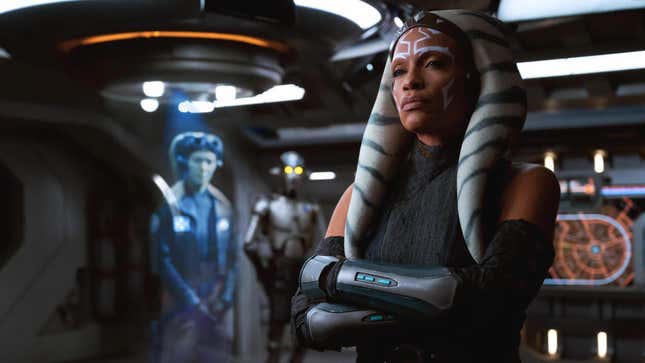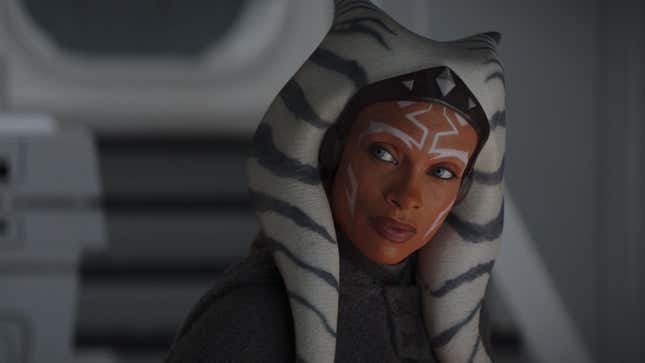Ever since Ahsoka Tano stepped out of the mists of Corvus and into live-action Star Wars historical past on The Mandalorian, I’ve had sophisticated emotions in regards to the path of one among my favorite Star Wars characters in modern canon. These emotions haven’t modified a lot within the opening episodes of her new titular series up to now—however watching them this previous week I discovered one factor giving me a tiny glimmer of the Ahsoka I keep in mind: the sentiments stirred by the present’s finish credit.
That’s not a selected dig at Ahsoka itself—I’m not relieved when an episode is over, by any means. Its first two episodes are perfectly fine set up, and considerably paradoxically at their finest on the moments the place the main target is positioned on characters like Rebels’ Sabine Wren and Hera Syndulla somewhat than Ahsoka herself. The collection crackles with a possible vitality when exploring Sabine’s emotions about her previous connection to Ahsoka and the Rebels crew, or within the enjoyable of watching Hera and her droid Chopper banter and fly cool ships like we’re excellent again into telling Rebels’ story another time.

That vitality, nonetheless, virtually vanishes when Ahsoka herself is on display. She seems like a indifferent observer in what’s ostensibly her personal collection, given a perspective in dialogue and within the lens of the path itself that makes it really feel like Ahsoka is way much less enthusiastic about Ahsoka Tano than it’s just about anybody else in her orbit, as she drifts from scene to scene with little greater than a show of Rosario Dawson folding her arms throughout her chest, able to intently observe the narrative unfolding earlier than her somewhat than actually take part in it.
And that’s simply sort of been Ahsoka’s vibe ever since she got here to Star Wars stay motion. In “The Jedi,” her debut in The Mandalorian, she seems like one thing of an aimless drifter, chasing leads right here and there but additionally distinctly delay by the thought of getting concerned when a possibility—in that case, the coaching of the younger Grogu as a Jedi— is put in entrance of her. Likewise when she returns in The Ebook of Boba Fett, she’s there to fade into the second, acknowledge that she’s a part of it as she watches Luke Skywalker—the son of the master she left behind and finally tried to combat to the loss of life after his horrifying transformation into Darth Vader—prepare Grogu and begin to rebuild the Jedi Order that when deserted her, after which fade again into the background, intent on staying uninvolved.

This in and of itself will not be solely a grievance both. As I alluded to, there’s a whole lot of potential in exploring this concept of Ahsoka, one of many most important people metatextually to fashionable Star Wars, virtually outright rejecting that significance within the story itself. She tried being the hero the galaxy needed her to be in her previous lives: a Jedi leader within the Clone Wars till the Council hung her out to dry, resulting in her parting methods with the Order. A citizen of the Republic, till it too turned on her by way of Palpatine’s machinations. An agent of Riot, till previous traumas noticed her minimize off from it in flip after her duel with Vader on Malachor. What does Ahsoka Tano owe this galaxy that’s precipitated her a lot harm over her life, to be its hero—to be the one which has to now cease Grand Admiral Thrawn because the ascendant Inheritor to the Empire?
The issue is that none of her live-action appearances up to now have actually engaged with that concept—Ahsoka has been left to be portrayed as distant and uninvolved however probably not explored as to why she is like that, at least so far. It’s irritating, but additionally one thing I’m not fairly keen to levy towards Ahsoka as a present simply but. In spite of everything, there’s one other six episodes for it to really deal with its titular character with the identical sort of dramaturgical curiosity it holds for Sabine and Hera. However I’m additionally not but keen to levy it towards Ahsoka for that peculiar factor I discussed earlier: the sensation sparked in me by Ahsoka’s finish credit music.
Kevin Kiner has been part of Ahsoka’s Star Wars life for the reason that very starting, having composed music for Clone Wars and Rebels—together with the 14-note leitmotif that has adopted her from that first film 15 years in the past all the best way to this finish credit sequence—and now Ahsoka, and that understanding of her lengthy journey, feels thematically resonant to the 4-minute orchestration that performs over the collection’ ending titles. And whereas a part of my frustration with Ahsoka’s live-action arc has been leaving a whole lot of her character as much as viewers supposition somewhat than being one thing that’s significantly a part of the textual content of her character on display, all of the occasions I discovered myself annoyed by Ahsoka’s seeming disinterest in its lead character Kiner’s music stored pulling me again to these suppositions, and making them really feel a bit extra actual in methods the remainder of the present wasn’t fairly doing.
The best way it builds this regular beat, the backwards and forwards of low, staccato strings evokes Kiner’s model from Clone Wars, earlier than being backed by this militaristic marching drum beat to amplify that feeling. There’s a willpower, a certainty to the music because it builds and builds these layers, that itself turns into transposed onto Ahsoka when the piece crescendos into her character leitmotif: a blaring brass part heralding this triumphant, hovering set of strings. It’s so heroic, so bombastic, it’s a celebration of what this character has meant out and in of Star Wars’ narrative—Ahsoka Tano, Jedi no extra, residing legend, a bridge throughout three generations of the Skywalker Saga! Is that this not what she is, what she is supposed to be? However then it quietens for a beat. Every little thing that constructed up attracts again. The drums fade away, the horns fade away, the string part fades away, till we once more return to Ahsoka’s leitmotif: not heroic however now mournful, melancholic, remoted to only a single major string and wind instrument in tandem. There’s a unhappiness to it, the unhappiness we’re meant to deduce of her character now that this live-action efficiency has so struggled to articulate.

However this piece does. And if in its remaining time Ahsoka as a present can compel me to consider its titular hero with as a lot feeling as this music does, it’ll be all I can ask of it.
Need extra io9 information? Try when to anticipate the most recent Marvel, Star Wars, and Star Trek releases, what’s subsequent for the DC Universe on film and TV, and all the pieces it is advisable to find out about the way forward for Doctor Who.
Trending Merchandise

Cooler Master MasterBox Q300L Micro-ATX Tower with Magnetic Design Dust Filter, Transparent Acrylic Side Panel, Adjustable I/O & Fully Ventilated Airflow, Black (MCB-Q300L-KANN-S00)

ASUS TUF Gaming GT301 ZAKU II Edition ATX mid-Tower Compact case with Tempered Glass Side Panel, Honeycomb Front Panel, 120mm Aura Addressable RGB Fan, Headphone Hanger,360mm Radiator, Gundam Edition

ASUS TUF Gaming GT501 Mid-Tower Computer Case for up to EATX Motherboards with USB 3.0 Front Panel Cases GT501/GRY/WITH Handle

be quiet! Pure Base 500DX ATX Mid Tower PC case | ARGB | 3 Pre-Installed Pure Wings 2 Fans | Tempered Glass Window | Black | BGW37

ASUS ROG Strix Helios GX601 White Edition RGB Mid-Tower Computer Case for ATX/EATX Motherboards with tempered glass, aluminum frame, GPU braces, 420mm radiator support and Aura Sync

CORSAIR 7000D AIRFLOW Full-Tower ATX PC Case – High-Airflow Front Panel – Spacious Interior – Easy Cable Management – 3x 140mm AirGuide Fans with PWM Repeater Included – Black








